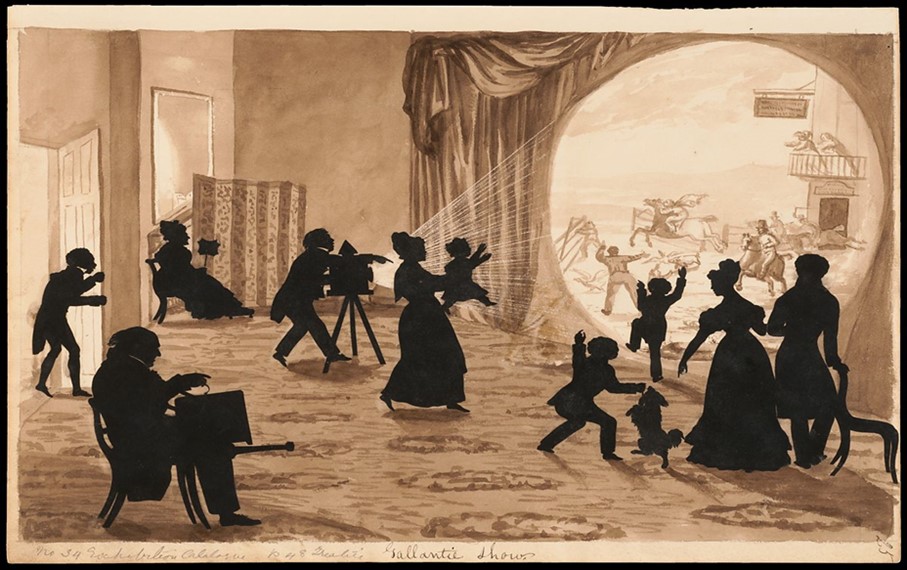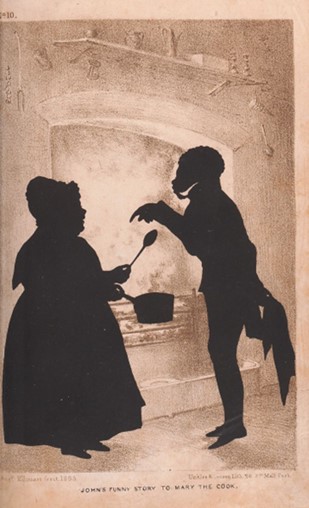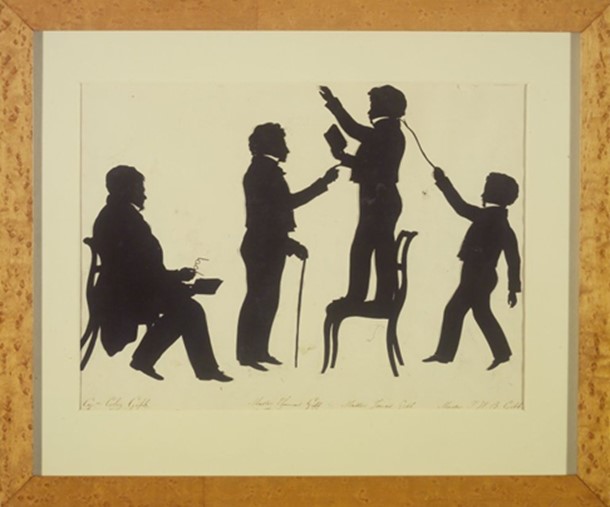by Lydia Newton
Auguste Edouart was a French artist known for his silhouette artworks. Extremely prolific in his day, given the niche nature of Edouart’s art he escapes mainstream popularity today. This piece aims to provide an entry into his world of profiles and focuses on several aspects of his portraiture that parallel key features of cartoons.
Born in Dunkirk, France, in 1789 – a period of extreme political turbulence – Edouart was one of sixteen children. At 19 years old, he fought in the Napoleonic wars and in 1814, he married Emilie Laurence Vital and travelled to London where he remained until 1829 when he moved to Scotland. Initially, he specialised in artworks made of hair – a painstaking and lengthy process. It is hardly surprising that his career began to flourish in the far more lucrative market of silhouettes where one profile could take him less than three minutes to make. It was in 1825, on being shown a silhouette made by a machine, that he produced some scissors and card and cut out the likeness of one of his companions. From this point, silhouettes became his bread and butter (Profiles of the Past). Producing thousands of profiles in his lifetime, these were quicker and cheaper to make than painted portraits. His portfolio is a formidable achievement given the control required to produce the likenesses using only scissors!
In 1839, Edouart travelled to the United States remaining there for ten years before returning to France. On his voyage home, thousands of his works were lost in a shipwreck. Thankfully, many were saved – indeed, it is said that he took duplicates of every portrait he completed (Profiles of the Past). Vast in quantity, Edouart also depicted a variety of subjects, including public figures such as the exiled royal, Charles X, William Dyce and Fanny Brawne (National Portrait Gallery). From familial scenarios in the drawing room, to urban scenes of the streets in Bath, he documents not only people but nineteenth-century life itself.

The Magic Lantern (ca,1835) elevates Edouart from being solely a portrait artist given the complexity of the composition. By definition, a silhouette is also inherently basic, created with nothing but black card – the detail can be seen in the form of the figures where the lines have been cut. The likenesses are achieved with skilled prowess but are not caricatures – whilst one dimensional and blank, no feature is disproportionate. Every detail is recognisable and achieved through a speedy medium, one which was possibly considered less ‘highbrow’ – a reputation which has also been held by cartoons at times. If the dictionary defines a cartoon as ‘a simplified or exaggerated version or interpretation of something’ (Oxford languages) or a ‘ludicrously simplistic, unrealistic, or one-dimensional portrayal’ (Merriam-Webster), then Edouart’s silhouettes fit nicely into that category.
Equally, if cartoons tell a story, in a humorous way at times, then there is certainly both a narrative and comedic component to many of Auguste Edouart’s silhouettes, as seen in The Magic Lantern and other compositions which I shall examine shortly. What Edouart has created is difficult to characterise – it is not only a silhouette; the scene is telling a story with various forms of entertainment moving the narrative along. A man is putting on a show using a magic lantern – these were images painted onto glass which were projected onto a screen through an illuminated lens. The figure with a wooden leg provides a musical accompaniment using a barrel organ (The Metropolitan Museum of Art). Not all the people are in profile. The man to the right and the two children face away from us, and are immersed in the show. One figure lifts her child to get a better view, another opens the door, and an elderly woman sits stationary in the background. The room is a hive of activity and a vignette into one afternoon’s leisure pursuits.
Cartoons tell a story with artists using various techniques to convey movement and emotion. Far from static, Edouart has cut the silhouettes to bring a sense of action. A child is lifted whilst another crouches down to play with a dog who is jumping up. Up and down and to and fro, the motion of the characters brings a vitality to the scene. Excitement, disapproval, concentration – these emotions are all evident in the stances of the characters.

Johnny’s Funny Story to Mary the Cook and The Magic Lantern demonstrate how Edouart represented a wide breadth of ages and social types in their daily lives. In the Funny Story, the subjects are starkly different to the middle/upper classes of The Magic Lantern. They are placed in front of a fire – one is a cook, the other is a servant. Whilst apolitical, the title adds a playful dimension to the figures reminiscent of Hogarth – Mary’s smile is visible, and Johnny lifts his coattails in one relatable motion.

Cut Silhouette of Four Full Figures contains a similar humorous streak. Two men (possibly tutors) are busy instructing the boys – one of whom playfully pokes the other with a stick, contrasting the solemn manner of the occasion. As we delve into Edouart’s portfolio, we are rewarded with more than just likenesses but stories, and beyond this, social products which serve as records for the period in which they were produced. Here, I have paralleled them loosely with several attributes of cartoons, using this lens as a tool for analysis and offering some information and interpretation. I have not discussed the context of his work in detail or, how the medium was almost completely halted by the invention of photography. There are many more questions to ask and answer and I encourage you to do so!
Further Reading
- “Cartoon.” Oxford Languages and Google, Oxford University Press, accessed 7th September 2022.
- “Cartoon.” Merriam-Webster.com Dictionary, Merriam Webster, https://www.merriam-webster.com/dictionary/cartoon. Accessed 7th Sep. 2022.
- Edouart, Auguste (McKechnie Section 1). Profiles of the Past: 250 Years of British Portrait Silhouette History, Profile of the Past, http://www.profilesofthepast.org.uk/mckechnie/edouart-augustin-mckechnie-section-1. Accessed 7th Sept. 2022.
- Edouart, Auguste. People and Portraits, National Portrait Gallery, https://www.npg.org.uk/collections/search/person/mp06932/augustin-edouart, Accessed 7th Sept. 2022.
- The Magic Lantern. Auguste Edouart, The Metropolitan Museum of Art, https://www.metmuseum.org/art/collection/search/365307. Accessed 7th Sept. 2022.


Leave a comment